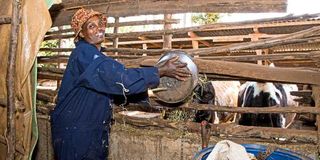How to strengthen extension services

A dairy farmer in Lari, Kiambu County, feeds her cows.
The shortage of extension services remains a significant challenge for farmers in Kenya, aggravated by a declining number of agricultural officers recruited by the government.
Despite the commitment by the Ministry of Agriculture and Livestock Development to improve the sector, the officers who retire, resign or die are often not replaced, with the government citing budgetary constraints.
Timely farming extension services are crucial for the country’s agricultural commercialisation agenda, transitioning from subsistence farming to thriving business enterprises.
The adoption of modern Technologies, Innovations, and Management Practices (TIMPs) plays an important role in linking farmers, agro-pastoralists, pastoralists and fisher-folk with other economic actors, fostering growth in agriculture.
However, the extension system has faced many setbacks over the decades, including weak research-extension-farmer linkages, inadequate financing and the training of personnel.
Digitising agricultural services through e-extension can bridge this large gap, providing smallholder farmers with timely and relevant information on crop and animal production.
Unfortunately, Kenya’s extension services are yet to fully embrace this approach.
Digitising extension services allows for real-time monitoring of production trends, prices and demand, enabling small-scale farmers to make informed decisions.
The government has initiated various projects and programmes within ministries to make operational extension policy guidelines, emphasising contracting of services and Community-Driven Development (CDD).
The National Agricultural Rural and Inclusive Growth Project (NARIGP) aimed to apply these attributes in extension, with a focus on value chain development for marketing produce from farmers.
In Lari Sub-County, Kiambu County, thousands of dairy farmers faced many challenges, resulting in low milk production.
This was mainly due to inadequate feeding of their animals.
Through NARIGP, these farmers received grants, enabling them to acquire essential dairy management skills and implement sustainable fodder production.
Knowledge-sharing and collective action have transformed the lives of dairy farmers in Lari.
NARIGP’s programme adopted a hybrid extension model involving public and private sector providers, including Sub-County Technical Teams (SCTTS), contracted Disruptive Agricultural Technologies (DAT) service providers and Community Based Facilitators (CBFs).
Lead farmers were trained, serving as village-based advisers, supporting fellow farmers in adopting technology and project implementation monitoring.
In partnership with Kalro, NARIGP developed appropriate Technologies, Innovations, and Management Practices (TIMPs) for dissemination by extension service providers.
A variety of technologies, tailored to local needs and ecological zones, were identified and incorporated into extension programmes.
This included improved indigenous chicken breeds, drip kit irrigation and new crop varieties.
With the evolving food economy and climate change, participatory extension approaches are essential.
Demonstrations, model plots, training sessions, and exchange visits enhance farmers’ knowledge base, enabling them to optimise resource utilisation and increase yields.
Through collaborative efforts, sustainable community institutions can be built, ensuring agricultural transformation and resilience in the face of climate challenges.





